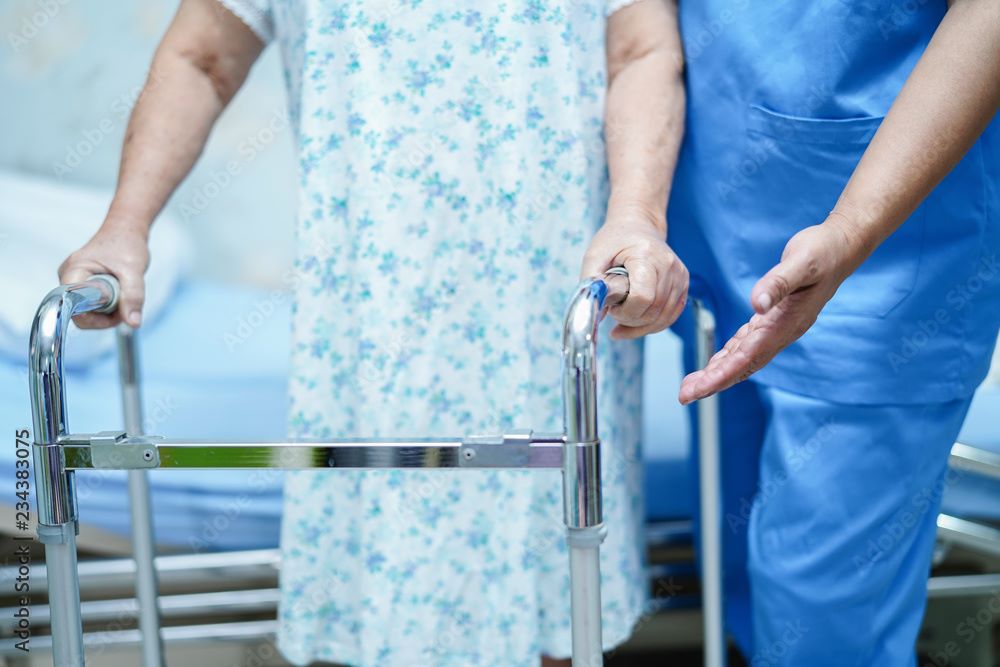How Soon Can You Walk After Knee Replacement? Quick Recovery Tips
Preparing for a knee replacement surgery can be frustrating when you’re not sure how you will feel and what you will be able to do after surgery.
One big question for me was “how soon can I walk after knee replacement surgery”?
I mean, think about it, you have to go to the bathroom, get your ice, get dressed, and get to appointments, especially your physical therapy sessions.
Knowing when you can walk after surgery can also be especially important if you don’t have a family member or friends to help you when you get home.
Can you go home? Will you need to go to a rehab facility for a short time?
As with everything when it comes to recovery, the timeline for walking can vary from person to person.
However, there are some common milestones that you can expect.
The day of surgery a physical therapist will encouraged to sit on the side of the bed and walk a few steps with a walker.
For me, it was about an hour after surgery when I had to pee – luckily, I had a nerve block during surgery, so this was not bad.
But watch out – when that thing wears off in 12-24 hours walking will suck!
However, whether you have a block or not, the sooner you can get up and moving the better. Walking stimulates blood flow and helps prevent complications.
Your walking will be very limited and painful at first.
You will need an assistive device, like a walker or crutches, to get around.
It’s important to remember that healing takes time.
Your body will set its own pace, and it’s important to listen to it and not push too hard or go too fast.

Understanding Total Knee Replacement Surgery
Knee replacement surgery, also known as knee arthroplasty, is a procedure where your damaged knee joint is replaced with an artificial one.
Surgeons remove the damaged bone and cartilage from your thigh bone, shin bone, and kneecap and then replace it with an artificial joint.
Why yes, it does hurt, as bad as it sounds!
But luckily, the pain is only short-term.
Post-Operative Recovery Timeline
Recovery after knee replacement surgery is gradual, and knowing what to expect can help you approach your recovery with confidence.
Below is a timeline for different stages of recovery.
Day of Surgery – Initial Walking Post-Surgery
If you think you will be able to rest in recovery, you are wrong!
While you are in the recovery room, your rehab will begin.
You will be encouraged to move your foot and do some simple exercises like heel slides and ankle pumps.
Compression stockings will be placed on your legs to help with blood circulation.
A healthcare provider, most likely a physical therapist, will have you sit on the edge of the bed, then stand and take a few steps with your walker.
Walking will be very difficult at first, so crutches are not a good idea.
Most people are released to home on the day of surgery – you’ll feel like you have been thrown to the wolves!

The First Few Days
I’m just gonna say it – the first week of walking will just totally suck!
You will begin outpatient physical therapy within 24 hours after surgery – so if you’re not up and going by then you will be!
Just getting to therapy is painful and exhausting.
But don’t worry – it will get better!
You will also be given specific exercises to do at home as part of your rehabilitation plan.
Yep, you guessed it, they will be grueling at first.
However, you’ve got to do them as instructed if you want to get back up and going again.
The exercises are designed to help you bend and straighten your leg as well as strengthen the muscles around your new knee.
Moving the leg and doing your exercises will also help to decrease your pain, swelling, and stiffness.
Walking short distances with a walker or crutches will be part of your daily routine by the end of the first few days.
So, no matter how bad it sucks, it’s best to just get up and get moving.
It will be much harder later if you delay walking and dog your exercise routine.
Weeks 1-2
Within the first week or two, you will continue physical therapy to increase the range of motion in your knee.
You should be getting stronger and beginning to wean off of your walker.
However, you may still need to use crutches. These, for me, were a bit dangerous since I really lack coordination! I guess that is what pushed me to work harder and get off the crutches before I fell and killed myself.
Most of us will no longer need the compression stockings, thank God! Those things are a pain in the ass to put on.
Just be sure to check with your healthcare provider before you stop wearing them. They may want you to continue wearing them longer due to pre-existing issues.
Managing your pain and controlling swelling will be key during this period, so be sure to give yourself a break and get plenty of rest while you ice and elevate the leg.
However, on the other hand you should also become more active and increase your walking during this time.
It will be a balancing act at first, trust me!!
If you’re up too much you will have increased pain and swelling, however, if you lie around too much you will get stiff and sore and possibly cause new complications such as blood clots.
Just listen to your body and of course your therapist – they will get you through this I promise!
Weeks 3-4
This is when you begin to feel human again.
You should notice decreased pain and swelling.
You are probably getting strong enough to ditch your crutches and either walk independently or just use a cane.
Walking should be better, and you should be able to go longer distances.
Getting in and out of the car and walking to and from therapy should be easier.
I was able to slowly go up and down stairs at this point with the help of the handrail.
Doing some light household chores – loading the dishwasher, doing some laundry, and making your bed should be tolerable by this time.
Whether this is good news or bad I’m not sure!
Low-impact exercises like swimming and riding a stationary bike could be an option to try at this point (but check with your therapist first – as I said, we are all different).
However, you should still avoid high-impact activities and activities that require heavy lifting.

Weeks 5-8
The first 6 weeks are by far the most important for getting your motion back in your leg.
If you don’t, it will become more difficult to get back later, so pull up your big girl/boy pants get to work!
By this time, you should be able to bend your knee to 90 degrees and fully extend your leg.
You should be walking independently and for longer distances.
Returning to your morning or after-dinner walks could definitely be worth trying again.
I was able to return to lifting lighter weights and riding my bicycle for short distances outdoors at this point.
If you have a sedentary job, you may be able to get back to work. I returned to work 8 weeks post-op, but I have a sedentary job with occasional walking and driving.
The big milestone during this period is that you should be able to get back behind the wheel of your car again!
READ MORE: How Long After A Knee Replacement Can You Drive? | Simply Aging Healthy
Months 3-6
During months 3 to 6, you will notice huge improvements in your strength and flexibility.
How far you can walk at this point is up to you!
Physical therapy sessions will stop during this period, but you should continue to include regular exercise in your daily routine.
Low-impact activities, indoor or outdoor, such as cycling, swimming, and hiking, are good at this point to help improve your endurance and knee function.
You should be getting back to your normal activities.
Depending on how labor-intensive your job is, you should be able to return to work in 4-6 months after surgery – if not before.

Walking After Knee Replacement – A Quick Guide
No one can tell you exactly how far you should be walking at any stage because every recovery journey is different.
Here is a guide to help you when it comes to walking after knee surgery.
- Day 1: Sit on the edge of the bed, stand, and take a few steps – mostly just to the bathroom and back as needed.
- Day 2-3: You will still be very limited in your walking, going only to the bathroom and physical therapy sessions will kick your butt!. Don’t push too hard or too fast—you can actually overdo it and end up with more swelling and knee pain.
- Weeks 1-2: You should be able to take short walks inside your house and to physical therapy. Begin weaning off your walker. Start using crutches or a cane.
- Weeks 2-4: At this point, climbing stairs should be an option. Your walking distance should improve significantly, and most people will no longer need assistive devices.
- Weeks 4-6: At this point in therapy, you should be working on strengthening so your walks will be much longer. Your activity level should be increasing, and you should be able to walk outside, climb stairs, and do minimal shopping. Most people will be back to driving again.
- Weeks 6-12: By this point, you should be walking pretty good and getting back to your normal everyday activities.
- Weeks 12 and beyond: You should be getting back to all of your normal activities and able to walk as much as you want. Try doing low-impact exercises like cycling, hiking, swimming, light weightlifting, and yoga.
Remember, your progress will depend on your physical status and fitness level before surgery, your overall health, and how hard you push yourself in physical therapy and home exercises.
Factors Affecting Recovery Speed after Knee Surgery
The speed of your recovery after a knee replacement can be different for may reasons.
So, it’s important to understand what can affect your healing process.
Individual Health Factors
- Overall Health: To me this is probably number 1. A strong immune system and being free of chronic conditions can lead to a quicker recovery.
- Weight: Yes, yes body weight does make a difference with a knee surgery. The lighter you are the less stress you put on your new knee joint which can speed up recovery.
- Fitness Level: The better your fitness level and the stronger you are before surgery the better your outcome. I worked out until the day before my surgery, and I truly believe that it helped me get back on my feet quicker.
- Age: I put this closer to the bottom of the list because I do struggle with this one as an orthopedic nurse. While it is true that most younger patients usually recover faster, it’s not always the case. I have taken care of many 70-80 years olds that could run circles around some 60-year-olds! I also have a friend that is 10 years older than me and recovered just as quickly as I did – so, to me, age is just a number!
Post-Surgical Care
- Physical Therapy: Don’t dog your therapy – you must be an active participate if you want to get better and back to your best self quickly! So, just plan to put in the work.
- Pain medication, ice, and elevation: Chronic knee pain and swelling can slow down the recovery period. So, be sure to take your pain medication as prescribed, ice the knee, and elevate your leg. It will be a balancing act between rest and activity, so listen to your body, push yourself when you can, and back off and rest when you need to.
- Healthy Diet: Be sure to eat a healthy, well-balanced diet with increased proteins for wound healing.
- Get Plenty of Rest: Sleep is often underrated but is extremely important. Letting your body rest and reset will help with your healing process. You probably won’t be able to get a good night’s sleep for a few weeks, so be sure to sneak in some time for napping. Don’t worry you will get back to your normal sleep pattern soon.
- Wound Care: Be sure to protect your wound site from anything that irritates it, like clothing and dirt. Do not soak the knee; do your wound care as needed. Observe the wound for redness, drainage, and odor. If you notice any of these, contact your healthcare provider.
Read More: Tips to Speed Up Recovery from Knee Replacement Surgery – Simply Aging Healthy
The Big Question: When Can You Walk After Knee Replacement?
After a knee replacement surgery, the timeline for walking can be different for everyone.
Most people will start walking with a walker on the day of surgery, guided by a physical therapist.
The rehab process is so important and usually involves many different exercises to strengthen the knee and improve flexibility.
Within 2-4 weeks you should be able to walk without assistance, but it may take months to completely recover and enjoy the plus side of the surgery.
So, tell me what surgery are you having, or did you have – a total or partial knee replacement?
I would love to hear your recovery story. What was your timeline for walking again?
I hope that it was easy, peasy, lemon squeezy!!

Tech to Force This is really interesting, You’re a very skilled blogger. I’ve joined your feed and look forward to seeking more of your magnificent post. Also, I’ve shared your site in my social networks!